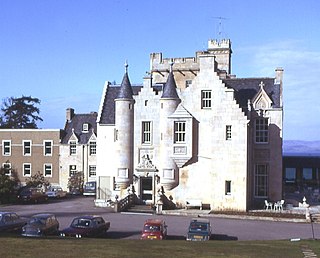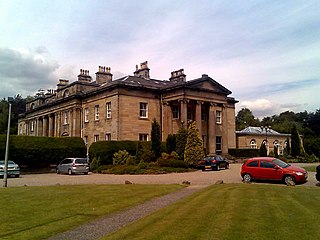
A broch is an Iron Age drystone hollow-walled structure found in Scotland. Brochs belong to the classification "complex Atlantic roundhouse" devised by Scottish archaeologists in the 1980s. Their origin is a matter of some controversy.

Shapinsay is one of the Orkney Islands off the north coast of mainland Scotland. There is one village on the island, Balfour, from which roll-on/roll-off car ferries sail to Kirkwall on the Orkney Mainland. Balfour Castle, built in the Scottish Baronial style, is one of the island's most prominent features, a reminder of the Balfour family's domination of Shapinsay during the 18th and 19th centuries; the Balfours transformed life on the island by introducing new agricultural techniques. Other landmarks include a standing stone, an Iron Age broch, a souterrain and a salt-water shower.

Kildrummy Castle is a ruined castle near Kildrummy, in Aberdeenshire, Scotland. Though ruined, it is one of the most extensive castles dating from the 13th century to survive in eastern Scotland, and was the seat of the Earls of Mar. It is owned today by Historic Environment Scotland and is open to the public as a scheduled ancient monument with gardens that are included in the Inventory of Gardens and Designed Landscapes in Scotland.

Brodick Castle is a castle situated outside the port of Brodick on the Isle of Arran, an island in the Firth of Clyde, Scotland. It was previously a seat of the Dukes of Hamilton, but is now owned by the National Trust for Scotland. The castle is a Category A listed building and the grounds are included in the Inventory of Gardens and Designed Landscapes in Scotland.

Balnagown Castle is beside the village of Kildary in Easter Ross, part of the Highland area of Scotland. There has been a castle on the site since the 14th century, although the present building was remodelled in the 18th and 19th centuries. It is the ancestral home of the Chiefs of Clan Ross, although since the 1970s it has been owned by Egyptian-born businessman Mohamed Al-Fayed. It is protected as a category B listed building, and the grounds are included on the Inventory of Gardens and Designed Landscapes in Scotland, the national listing of significant gardens.

Burroughston Broch is an Iron Age broch located on the island of Shapinsay in the Orkney Islands, in Scotland. The site overlooks the North Sea on the northeast part of Shapinsay. Excavated in the mid 19th century, Burroughston Broch is still well-preserved. The drystone walls are up to four metres thick in some parts and there is a complete chamber intact off the entrance passage. Some remains of stone fittings are evident in the interior.

Vasa Loch is a brackish lagoon in southwestern Shapinsay, Orkney Islands. This water body has been shown on early maps of the island in a very similar shape and size to its current geometry, separated from the North Sea by a narrow strip of raised beach.(Masters, 1840) Vasa Loch is fed by small rivulets and upland springs that rise on the western part of the island's western spur. pH levels of the loch are strongly alkaline, in the range of 10.15.

Mill Dam is a wetland in western Shapinsay, in Orkney, Scotland.

Mor Stein is a neolithic standing stone in the southeastern part of the island of Shapinsay, Orkney Islands, Scotland. Shapinsay is one of the two large inner islands of the Orkney group, and it is situated approximately two miles north of the Orkney Mainland. Linton Bay is situated slightly to the northeast of Mor Stein.

Balfour is a village on the island of Shapinsay, Orkney. The village is situated on Elwick Bay, which was used as an anchorage by Haakon IV of Norway before sailing south to eventual defeat at the Battle of Largs in 1263. Today, the village still possesses a harbour, with mock defensive walls constructed at the same time as the castle. David Balfour even added a stone marked with the date 1725, taken from Noltland Castle on the island of Westray, to his defences. A car ferry to Kirkwall, operated by Orkney Ferries, sails from a pier at the harbour. This became a roll-on/roll-off service in 1990.

Dundas Castle is a 15th-century castle, with substantial 19th-century additions by William Burn, in the Dalmeny parish of West Lothian, Scotland. The home of the Dundas family since the Middle Ages, it was sold in the late 19th century and is currently the residence of politician and businessman Sir Jack Stewart-Clark. The tower house and the adjoining Tudor-Gothic mansion are listed separately as Category A buildings, and the grounds are included in Inventory of Gardens and Designed Landscapes in Scotland.
Lairo Water is a surface water body known as an ayre situated on the western coast of Shapinsay in the Orkney Islands. This brackish water body is separated by a narrow bar of land from Veantro Bay. This wetland is an area where a variety of bird species may be found. Hogan has suggested that the Lairo Water may have been a source of subsistence food for prehistoric inhabitants of Shapinsay at Burroughston Broch.
Veantro Bay is a bay on the northwest coast of Shapinsay in the Orkney Islands, Scotland.

Castle Bloody is a prehistoric feature on the island of Shapinsay, Orkney, Scotland. Hogan observes that while the feature is marked as a chambered mound on the UK Ordnance Survey map, the structure is more properly and specifically classified as a souterrain or earth house. Slightly to the north is located the ruined historic Linton Chapel.

Quholm is a hamlet in the northeast of Shapinsay, in the islands of Orkney, Scotland. William Irving, the father of Washington Irving, noted American author, was born in Quholm. Innsker Beach is situated very close by at the northwest edge of Quholm. Slightly to the south along Shapinsay's northwest coast are located the coastal ayres of Lairo Water and the Ouse situated within Veantro Bay. There are significant archaeological sites not distant from Quholm, including Odin's Stone, Burroughston Broch, Linton Chapel, Castle Bloody and Mor Stein.

Prehistoric Orkney refers only to the prehistory of the Orkney archipelago of Scotland that begins with human occupation. Although some records referring to Orkney survive that were written during the Roman invasions of Scotland, “prehistory” in northern Scotland is defined as lasting until the start of Scotland's Early Historic Period.

Stonefield Castle is a Scottish baronial manor house near the village of Stonefield, north of Tarbert, Argyll & Bute, Scotland. It was built on the site of an earlier building, known as Barmore, and has been in use as a hotel since 1950.

Dawyck House is a historic house at Dawyck, in the parish of Drumelzier in the former Peeblesshire, in the Scottish Borders area of Scotland. The alternative name is 'Dalwick House'. Canmore ID 49816.

Stobo Castle is located at Stobo in the Scottish Borders, in the former county of Peeblesshire. The Manor of Stobo was originally owned by the Balfour family. It became the family seat of the Graham-Montgomery Baronets from 1767. The building of the present castle began in 1805 and was completed in 1811 under the supervision of architects Archibald and James Elliot. It is currently operated as a health spa. The house is protected as a category A listed building, while the grounds are included in the Inventory of Gardens and Designed Landscapes in Scotland, the national listing of significant parks and gardens.

Balbirnie House is an early 19th-century country house in Glenrothes, in central Fife, Scotland. The present house was completed in 1817 as a rebuild of an 18th-century building, itself a replacement for a 17th-century dwelling. The home of the Balfour family from 1640, the house was sold in 1969 and opened as a hotel in 1990. The grounds now comprise a large public park and a golf course. The house is protected as a category A listed building, while the grounds are included in the Inventory of Gardens and Designed Landscapes in Scotland.



















